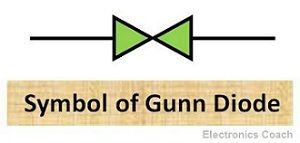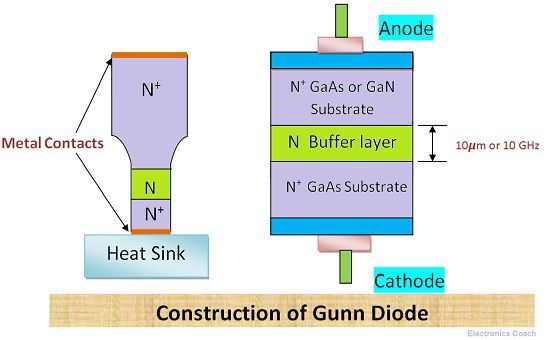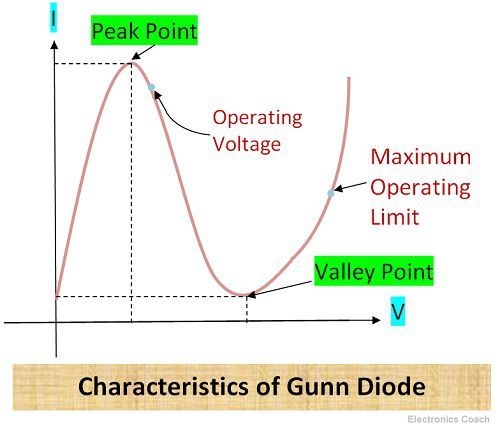Definition: Gunn diode is a transferred electronic device, which is composed of only one type of semiconductor i.e. N-type and utilizes the negative resistance characteristics to generate current at high frequencies. It is used to generate RF and microwave frequencies.
It is composed of only N-type semiconductor because N-type semiconductor has electrons as majority carriers. And transferred electronic devices use such materials which have electrons as majority charge carrier.
For such devices, the P-type semiconductor is of no use because it consists of holes as majority carriers. Therefore, Gunn diode is made up of only N-type semiconductor, not P-type.

Construction of Gunn Diode
It is made up of three layers of N-type semiconductor. The semiconductors used in Gunn diodes are Gallium Arsenide (GaAs), Gallium Nitride (GaN), Cadmium Telluride (CdTe), Cadmium Sulphide (CdS), Indium Phosphide (InP), Indium Arsenide (InAs), Indium Antimonide (InSb) and Zinc Selenide (ZnSe).

Among these three layers the top most and the bottom most are heavily doped while the middle layer is lightly doped in comparison to the extreme layers. The middle layer is an epitaxial layer grown on the N-type substrate and the top most layer is formed by ion implantation technique.
The metallic contacts are provided on extreme layers to facilitate biasing. The heat sink is there so that the diode can withstand excessive heat and can be prevented from damage.
Working of Gunn Diode
The Gunn diode is not actually a P-N junction diode because there is no P-region and no junction. But still, it is called diode because of involvement of two electrodes. When biasing is applied to Gunn diode, the entire voltage appears across the active region. The active region is the middle layer of the device. The active region is 6-18m long.
Due to which the current pulses start traversing the active region. The potential gradient will fall when current pulse traverses in the active region which blocks another pulse to form. The next current pulse will form only when the previous current pulse has traversed the entire active region or it will be on the end of the active region. In this way, the thickness of active region modifies the frequency at which the device is working.
This is a transferred electronic device so it deals with the movement of electrons only. In Gunn diode, there is valence band, conduction band and one more band near conduction band. Thus, on initial DC bias the current through the device increases because electrons move from valence band to conduction band.
After moving in conduction band the current through the device starts decreasing because the electrons in conduction band move to band above the conduction band. Due to this the effective mass of electrons starts increasing and thus mobility starts decreasing due to which the current starts decreasing, And this creates the negative resistance region in the diode.
In this negative resistance region, the current starts increasing with the fall in voltage and will starts decreasing with increase in voltage. Thus, it generates pulses with phase reversal and thus this device is appropriate for the fabrication of amplifier and oscillator circuits. It generates frequency ranging from 10 GHz to THz.
V-I Characteristics of Gunn Diode
The Current in Gunn diode starts increasing initially with the applied DC voltage. At a particular point, the current starts decreasing this point is called threshold point or peak point.

After crossing threshold point the current starts decreasing and this creates negative resistance region in the diode. Due to this negative resistance region, the diode acts as amplifier and oscillator. In this negative resistance region, the Gunn diode is able to amplify the signals.
Advantages of Gunn diode
- Portable and Small Size device.
- The cost of manufacturing of Gunn diode is low.
- It possesses better noise to signal ratio as it is immune from noise disturbance.
- The Gunn diode is reliable and stable at higher frequencies.
- It has a high bandwidth of operation.
Disadvantages of Gunn Diode
- The Gunn diode has poor temperature stability.
- The device operating current is higher and therefore power dissipation is more.
- The efficiency of Gunn Diode is low below 10GHz.
Applications of Gunn Diode
- Gunn Diodes are used as oscillators and Amplifiers.
- They are used in radio communication, military and commercial radar sources.
- Gunn diodes are used as fast controlling equipment in microelectronics for modulation of laser beams.
- It is used in tachometers.
- Gunn diode is used in sensors for detection in trespass detecting system, in-door opening system, pedestrian safety systems etc.
- It is also used extensively in microwave relay data link transmitters.
These are the advantages, disadvantages and applications of Gunn diode. These are extensively used in sensors in the detection system.
hamad ullah says
i appreciate your explanation of gunn diode
thanks alots
Krati P says
Thank you for your support !!! It’s a matter of huge pleasure for us that our contents are helping you to explore concepts of electronics.
Narendra Jadhav says
The language used is very sophisticated and explicit. The content is crystal clear. Good job.
NOBODY says
Thanks for the great content!